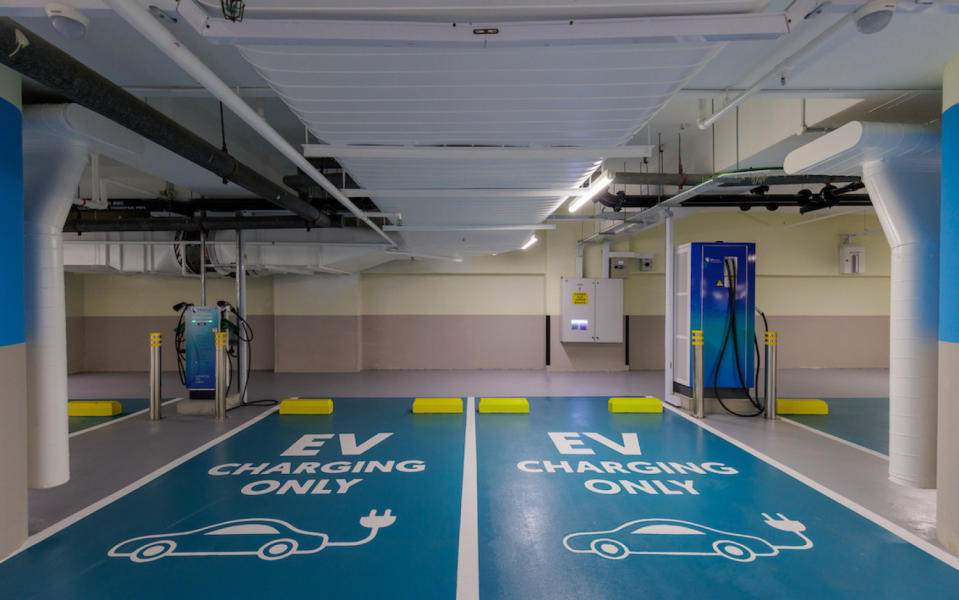Infrastructure set to benefit from real estate industry’s drive to net zero

Singapore already has 1,800 public charging points across the country and is planning to install 60,000 charging points by 2030 (Photo: Samuel Isaac Chua/EdgeProp Singapore)
Across the world, real estate owners are under more pressure than ever to reduce their buildings’ carbon emissions. According to the World Green Building Council, buildings are responsible for close to 40% of all global emissions, which means cutting emissions is essential to achieving the United Nations’ (UN) net zero goal by 2050.
As we strive to achieve this target, real estate is increasingly the focus for governments looking to reduce emissions. With risk in mind, investors are racing to limit their exposure to real estate assets that may soon become non-compliant under new energy efficiency legislation.
Rapid action is needed now. Atmospheric carbon dioxide levels are 50% higher than at the start of the industrial revolution, which has already resulted in global warming of 1.1C. The Intergovernmental Panel on Climate Change’s AR6 Synthesis Report: Climate Change 2023 highlights the need for urgent action in the next seven years to limit the global average temperature rise to 1.5C. To put this challenge into context, carbon dioxide emissions will need to drop by 43% compared to 2019 levels in just seven years.
Investment boon
The major role infrastructure can play in helping lower emissions — from both the construction and operation of buildings — is often overlooked, misunderstood or both. But real estate investors should not underestimate this investment boon for the infrastructure sector, with long-term, often inflation-linked, secure returns available through the global real estate sector’s need to decarbonise.
And there are many infrastructure sectors that will be deployed to support these decarbonisation objectives. Take, for example, Green Peak Energy — a company that CBRE Investment Management (CBRE IM) is partnering and that provides solar energy infrastructure, including roof-mounted photovoltaic panels for industrial and commercial real estate in Australia and New Zealand. Investors benefit from long-term, stable cash flows, while real estate owners have access to low-cost energy and reduced carbon emissions, at the same time avoiding the high initial capital costs for installation and ongoing maintenance costs.
CBRE IM’s private infrastructure team is also evaluating district heating and cooling solutions, which introduce new and proven sustainable technology to high-density residential and commercial buildings. In the EU, new legislation aimed at reducing the use of gas boilers is providing a favourable framework for investment. Similar policies are likely in Asia as pressure mounts to reduce dependence on fossil fuels.
While Asian regulation might lag behind the EU in sustainability reform for district heating and cooling, recent developments in the data centre (DC) space show the leading role Asia is playing in the shift to decarbonisation.
In 2019, Singapore announced a moratorium on new DC capacity, citing concerns about increasing power and land use needs. Fast forward three years and the Singapore government now has a pilot programme to promote the growth of data centres that offer high-quality technical performance, energy efficiency and efforts to decarbonise.
In July 2023, Phase 1 was finalised with the approval of 80MW of new data capacity spread across four global operators. Applicants were instructed to present a “roadmap focused on the development of DCs with lower carbon emissions in support of Singapore’s net-zero targets”.
With DC platforms commonplace among global infrastructure portfolios as long-life assets, delivering an essential service and underpinned by long-term contracts, we see the modernisation of this sector and the role it can play in urban communities as having significant potential to spur new investment opportunities across digital and sustainability-focused infrastructure sectors. These include short-term innovation projects such as behind-the-meter energy solutions, utilising waste heat for district heating purposes, as well as longer-term plans for regional import power grids and green hydrogen technologies.
Beyond the benefits of decarbonising physical real estate assets, there are ancillary opportunities available to real estate operators that can be obtained through investing via infrastructure strategies.
For owners of logistics buildings in urban locations that support last-mile delivery to a customer’s doorstep, the pressure to cut transport emissions is rising; vehicles and the emissions they generate pose health hazards to local communities.
EV charging market
One way infrastructure investors can help urban logistics buildings meet the challenge is by providing electrical vehicle (EV) charging infrastructure. The infrastructure investor who owns the EV charging points benefits from secure long-term inflation-linked contracts with the building’s owner and/or transport operators, who can be a high-quality counterparty. These long-term commercial contracts have many similarities with DC platforms, particularly the ability to pass through higher energy costs.
Transport is a major contributor to greenhouse gas emissions, being responsible for 28% of the global total, as well as harmful pollution. Governments in Asia have ambitious targets to cut transport emissions: Singapore, for example, aims to cut peak land transport emissions by 80% by or around mid-century, with vehicle fleet electrification being an important part of its plan.
This means huge potential exists in Asia for investors to tap into the EV charging market, where there has been positive momentum towards investment in the production of EVs and the supporting infrastructure. Singapore already has 1,800 public charging points available across the country and is planning to install 60,000 charging points by 2030. Neighbouring Malaysia is similarly ambitious, with plans to build 25,000 public charging points and 60,000 private charging points across the country by 2030.
Infrastructure and real estate investors share similarities in what they are seeking from investment returns — long-term stable returns through the provision of essential services such as energy, data, transport or accommodation space. By partnering, both infrastructure investors and real estate owners stand to benefit from a powerful range of mutually beneficial factors.
Real estate owners gain from infrastructure investors’ access to capital for their real estate assets’ transition to a net zero future, while infrastructure investors can capitalise on long-term, inflation-linked returns. The real estate industry also benefits from environmentally compliant buildings, which have secure asset values. Importantly, their properties will also appeal to occupiers looking to minimise the impact they have on the environment.
Although the transition to net zero is a challenge, it presents a unique collaboration opportunity for real estate owners and infrastructure investors.

Nick Riordan is senior director, infrastructure solutions, CBRE Investment Management, based in Singapore
See Also:
Singapore Property for Sale & Rent, Latest Property News, Advanced Analytics Tools
New Launch Condo & Landed Property in Singapore (COMPLETE list & updates)
En Bloc Calculator, Find Out If Your Condo Will Be The Next en-bloc

 Yahoo Finance
Yahoo Finance 